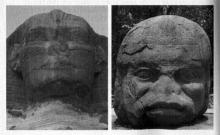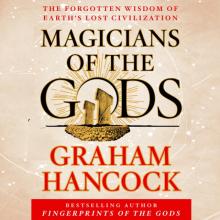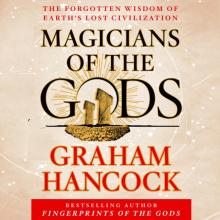- Home
- Graham Hancock
The Master Game Page 3
The Master Game Read online
Page 3
To have a full understanding of how talismans work, and knowledge of exactly where, how and when to apply them for maximum effect, is to be in possession of a potent arsenal of intellectual weaponry that can be used to change, reform, transform or, as the case may be, overthrow entrenched social and cultural systems … and also replace them with new ones. Kingdoms, empires, whole civilizations have been brought down with such intellectual weaponry, and the amazing thing is that in the most successful assaults not a single shot was fired or a single bomb exploded; furthermore the intellectual war was fought with one side entirely oblivious of where the attacks came from and unable to assess the damage inflicted until it was too late.
In 2009 the American novelist Dan Brown published his latest thriller, The Lost Symbol, which purported to unmask the true ‘Masonic’ mission and the meaning of the strange city layout of Washington, DC. Although the plot was largely fictional, the historical and urban settings he used were rooted in reality. The initial result of such wide popularization in semifictional blockbusters is that several millions of people are now aware of a possible covert mission to turn the capital of the United States into a Masonic ‘experiment’ using talismanic symbolism in the layout of streets and positioning of stately buildings and monuments. Another, more pertinent result, is that some residents of Washington, DC have become preoccupied by the real possibility that they live, eat, work and play inside a giant ‘Masonic temple’ that is their city. Yet neither Dan Brown nor anyone else as far as we know has been able to explain exactly why such a strange city plan was created in the first place nor, too, what ultimate function such a scheme might truly serve.
But as we emphasized earlier, to get to grips with this conundrum one must go back to the very roots of the ideologies that fired such a scheme and track its evolution and transmission across the ages. It is an intellectual journey that is truly worth the effort because at its end of the voyage, as happened with us, a veil will be lifted to reveal a strange world that was always there and yet is invisible to the uninitiated eye.
Prologue:
The Sacred Cities
The boat of Isis, a feast which was celebrated in Rome with great pomp, was known as Navigium Isidis; after it had been launched in the water, it was brought back to the Temple of Isis and prayers were made for the prosperity of the emperor, for the empire and for the Roman people …
François Noël, Dictionnaire de la fable
No one ignores that Paris was originally enclosed in the island [the Île
de la Cité]. It was thus, since its origins, a city of navigation … As it was
in a river rife with navigation, it took as its symbol a boat, and as tutelary
goddess, Isis, goddess of navigation; and this boat was the actual one of
Isis, symbol of this goddess.
Antoine Court de Gébelin, Monde primitif analysé et comparé avec le monde moderne
CHAPTER ONE
BEHIND THE VEILS
On 14 July 1789 a furious crowd ran riot on the streets of Paris and stormed the great prison known as the Bastille. Less than an hour later the fate of France hung in the balance and European history seemed set on a new and alarmingly unpredictable course.
Contemporary engravings of the Bastille show a forbidding rectangular structure flanked by eight tall towers. It does not look easy to storm. Built in the late 14th century as a fortress to protect eastern Paris, it was converted in the 17th century into a squalid and ghastly prison for dissidents. By the time of the Revolution it was firmly established in the public mind as an instrument of tyranny and as a powerful symbol of the despotism of the French crown.
The day after the storming of the Bastille an enterprising local contractor, Monsieur Pierre-François Palloy,1 took it upon himself to mobilise a workforce of 800 citizens to dismantle the hated prison stone by stone.2 The work was so well done that within a month most of the structure had been reduced to rubble with only a small part of the perimeter wall and foundations still intact.
At this point something curious occurred. The suggestion was made, and for a while taken seriously, that the stones of the Bastille should be salvaged in order to construct a replica of an ancient Egyptian pyramid on the site.3 And although the project later stalled for lack of funds, the core idea of making a symbolic connection with ancient Egypt persisted behind the scenes. If a pyramid could not be managed something less would have to suffice. Thus it was that on 10 August 1793 a group of revolutionaries ceremoniously installed a large statue of the ancient Egyptian goddess Isis where the Bastille had formerly stood. Depicting the goddess seated on a throne flanked by two lions, the statue had been conceived by Jacques-Louis David, the famous artist and propagandist of the revolution. It was to be one of the props in a macabre republican feast hastily put together in order to celebrate the decapitation of King Louis XVI six months previously and the forthcoming guillotining of Queen Marie-Antoinette still two months ahead.
The sculptors, François Marie Suzanne and Pierre Cartelier, did not have sufficient time to cast the statue in the preferred medium of bronze so they simply moulded it in plaster and coloured it with bronze paint.4 From the bare nipples of the ‘goddess Isis’ could be seen water being ejected into an open basin below the statue. Known as the ‘Fountain of Regeneration’, the general idea was for the crowd of people to pass in procession in front of ‘Isis’ and drink ‘from her fertile breasts the pure and salutary liquor of regeneration’.5
De-Christianisation
Everyone knows that philosophical ideas, notably those of Jean-Jacques Rousseau and Voltaire, were part of the ferment that led to the French Revolution. Still it is hard to explain why an overtly religious ritual – such as the Isis ceremony described above – should have received official sponsorship from the revolutionary government as early as 1793. That it did so, moreover, on a site so powerfully symbolic as the Place de la Bastille, raises an interesting question. Is it possible that spiritual and even ‘religious’ beliefs could have played a greater role than has hitherto been recognised in precipitating and sustaining the changes that gripped France after 1789.
For example, although the matter has been little studied, it became clear in the early days of the Revolution that its core objectives included not only the eradication of the monarchy and a radical readjustment of the social and economic order, as might be expected, but also another, even more far-reaching goal: the eradication, no less – one might almost say the extirpation – of Christianity from the soil of France. This objective was adopted as official policy in the winter of 1793, a few months after the Isis rituals at the Bastille, and set in train an intense and systematic national campaign of ‘de-Christianisation’.6 As French historian Michel Vovelle sums up, this now almost forgotten facet of the Revolution was not some passive and progressive attempt at conversion, but a methodical and forceful enterprise imposed though violence and intimidation.7
Why this sudden rush to stamp out Christianity?
Was it just that the Revolutionaries saw Christianity as a rival for the loyalty of the masses and hated and resented the ancient ties between the monarchy and the Church?
Or was there another, deeper game being played?
Very Christian Kings beheaded by the Cult of the Supreme Being
The kings of France liked to trace their origins back to the Merovingians, a Frankish dynasty of the fifth to the eighth centuries AD. Nothing is known about Merovech, the semi-legendary founder of the dynasty, but his son Childeric I is a historical figure who ruled a tribe of Salian Franks from his capital at Tournai circa AD 470. In AD 481 or 482 Childeric was succeeded by his son Clovis I who united almost of all of Gaul and converted to Christianity around AD 496.
Clovis died circa AD 511, but the Merovingian dynasty continued to rule much of what is now France until AD 750. It was succeeded by the Carolingian dynasty which gained great renown circa AD 800 with the dramatic coronation by Pope Leo III of Charlemagne as the very first ‘Holy Roman
emperor’. Thereafter all kings of France were regarded as the protectors of the Roman Church and to this effect bore the title Roi Très Chrétien – ‘Very Christian King’. Indeed so pious were France's medieval kings that one of them was actually canonised as a saint – Louis IX, a hero of the Crusades, who we will meet in Part I.8
Meanwhile to return to that terrible year of 1793 – 4 – the year, in fact, of the revolutionary ‘Terror’ with its unruly orgy of beheading – a different kind of religious phenomenon was suddenly widely observed in France: Catholic priests began to ‘abdicate’ their positions in droves9 and a new, officially-sponsored cult was launched by the Convention (the Revolutionary government) within recently ‘de-Christianised’ churches and cathedrals all across the land. Sometimes referred to as the ‘Cult of Reason’ but more commonly as the ‘Cult of the Supreme Being’, it seems that this new religion was the brainchild of the revolutionary leader Maximilien Robespierre and that its establishment was masterminded once again by the artist Jacques-Louis David (who had previously been involved in the Isis/Bastille stunt).
The tricolor goddess with the Phrygian cap
In street festivals staged during the French Revolution, the ‘goddess Reason’ was routinely personified by an actress garbed with a tricolor red, white and blue veil and wearing the so-called Phrygian cap. This same little red cap was in great vogue with the general public in the early part of the Revolution and was worn especially by the sans-culottes (‘without culottes’), the most zealous faction who partook in the thousands of guillotine executions in Paris and throughout the country.
The Phrygian cap is the typical headwear of two well-known pagan deities: the goddess Cybele and the god Mithras.
Cybele was the one of the great mother goddesses of antiquity and, more particularly at one stage of Roman history, whose ‘republic’ the French revolutionaries tried to emulate. As the name of her cap suggests, her cult origins were in ancient Phrygia (modern Turkey). In statuary she was routinely associated with two lions, either depicted harnessed to her chariot or flanking the ceremonial throne used by the high-priests of her cult. Medieval and Renaissance scholars frequently identified her with the ancient Egyptian goddess Isis. It therefore seems unlikely to be an accident that a Cybele-like goddess was to figure so prominently in the iconography of the French Revolution – for example in the so-called Génie de La République, a marble sculpture by the artist Joseph Chinard, made in the aftermath of the fall of the Bastille, which shows ‘République’ as a young woman in Graeco-Roman garb wearing the Phrygian hat.10
In the strange and terrible year of 1793 – 4 the so-called Cult of Reason spread like wildfire in the French provinces alongside the de-Christianisation process. It became common to witness large processions, or street theatres, in which the ‘goddess Reason’ wearing the Phrygian cap was towed on a cart to the nearest church or cathedral. Such events might look like nothing more than excuses for men and women to get drunk together, yet in France there were always more serious undertones. On 7 November 1793 for example no less a figure than the bishop of Paris, was forced by the Convention to recant his faith. Three days later, on 10 November, huge celebrations were organised at his cathedral in honour of the alternative Cult of Reason.
As the highlight of the celebrations a certain Mlle Aubry, a beautiful and popular actress wrapped in a white veil and blue tunic and wearing the red Phrygian cap, emerged from a ‘temple’ dedicated to ‘philosophy’ and was sat on a throne while the crowds came to pay homage to her. The procession then marched to the Convention, where Citizen Chabot, a zealous revolutionary and one of the co-architects of the new cult, decreed that henceforth the Cathedral of Notre Dame in Paris, the oldest and most revered Christian sanctuary in the land, was to become the ‘Temple of Reason’. Several ceremonies then followed where the role of the ‘goddess’ was assumed by various Parisian beauties, among them Mlle Maillard, Mlle Lacombe and Mme Momoro.11
The obelisk and the painting
In 1813, twenty-six years after the storming of the Bastille, the great culture-changing momentum of the French Revolution seemingly came to a grinding halt with the defeat of Napoleon. Seizing the moment, the exiled Count of Provence, Louis-Stanislas-Xavier, elder brother of Louis XVI, promised the French people that he would uphold some of the tenets of the Revolution in a new form of monarchy. Then, advised by the brilliant statesman Talleyrand, he entered Paris in May 1814 where he was received with open arms by the war-weary French and, amid much jubilation, was installed on the throne as Louis XVIII.12
Louis XVIII ruled for ten years. He was a Freemason – on his death in 1824 he was succeeded by his brother, the Count of Artois – also a Freemason – who took the name Charles X. Both monarchs showed a marked preference for ancient Egyptian symbolism in their public works and two projects of Charles X are of particular interest in this regard. The first involved transporting an intact ancient Egyptian obelisk to Paris. The second called for the commissioning of a gigantic painting in the Louvre.
The obelisk
In 1827, Jean-François Champollion (dubbed the ‘father of modern Egyptology’ for his breakthrough decipherment of ancient Egyptian hieroglyphs) was commissioned by Charles X to arrange for the importation to Paris of a 3,500-year-old obelisk – one of a pair – that stood at Alexandria in Egypt.13
The obelisk was destined for the Place de la Concorde, a prestigious location of great personal significance to Charles X. It had originally being named in honour of his father, Louis XV, an equestrian statue of whom had once graced it. But the statue had been pulled down and destroyed during the 1789 Revolution and the site renamed by the Convention as ‘Place de la Concorde’. Here also the guillotine had been erected that had beheaded Louis XVI in January 1793 and Marie-Antoinette in October of the same bloodstained year. May we speculate that the installation of the obelisk was to commemorate the idea of a reborn and restored monarchy, with the ancient solar symbol of the divine kings of Egypt rising in the heart of the Parisian skyline like a ‘phoenix’?
The painting
Charles X’s second noteworthy project was to commission the artist François-Édouard Picot to decorate the ceiling of his personal museum at the Louvre with a specific ‘Egyptian’ theme.
Picot, like many promising artists of the time, had studied under the master, Jacques-Louis David – the man responsible for the statue of Isis in the Place de la Bastille. We should not be surprised, therefore, that the very same ‘Isis’ is found on Picot's painting for Charles X.
Still decorating a ceiling of the Louvre, the great work was completed in 1827 and measures roughly 5 x 4 meters. Its title is L’Etude et le Génie dévoilent à Athènes l’Antique Egypte (‘Learning and Genius Unveil Ancient Egypt to Athens’). The figure of Isis dominates the scene and is depicted seated on a throne flanked by two lions – as was the case with David's earlier Isis of the Bastille. The viewer, however, is immediately drawn to contemplate the sky above the goddess, where can be seen flying two angels in the act of ‘unveiling’ the secrets of Isis.
We catch a tantalising glimpse of a haunting landscape containing in the far distance an obelisk and a group of pyramids at which Isis languidly casts her gaze. From the clouds next to the angels, the Greek goddess Athena appears with an owl at her feet symbolising initiation and wisdom. To the left of Athena is a winged-goddess wearing a laurel wreath symbolising ‘Learning’ (l’Etude). To the right of Athena is the so-called Génie de Paris, a naked winged youth brandishing a torch in order to illuminate and reveal to Athena the Egyptianised landscape below.
After the abdication of Charles X in 1830, Louis-Philippe I became the new ruler of France. Also known as the ‘Citizen King’, he commissioned a monument to commemorate the Trois Glorieuses, those three days of 26, 27 and 28 July 1830 that marked France's Second Revolution. This monument, which was completed in 1836, is a tall pillar erected in the Place de la Bastille on the very spot where David had positioned his statue of Isis in August
1793. On top of the pillar is a close replica of the winged youth with the torch seen in Picot's painting in the Louvre.
Is Picot reminding us that here, below the winged Génie de Paris, had once been a statue of Isis as also seen in his painting?
Coincidence, or blueprint?
Let us imagine ourselves in Paris today, riding in a helicopter above the Bastille pillar and looking westward, along the line of sight of the Génie de Paris. We are hovering over the city's oldest and most sacred quarters. Sprawled beneath us are some of the most impressive buildings and monuments that Paris has to offer. To our left runs the Boulevard Henri IV leading to the River Seine. The river itself runs roughly from east to west, and thus parallel to our westward line of sight, while beyond Boulevard Henri IV is the old Pont Sully arching over the eastern edge of the Île St. Louis with its famous abbey of the same name. The western tip of the island is linked by a pedestrian bridge to the much larger Île de la Cité, site of the celebrated Cathedral of Notre Dame and the impressive Palais de Justice.
Across the Seine is the tall bell tower of the Abbey of Saint-Germain-des-Prés – the latter, as we shall later see, intriguingly once a sanctuary dedicated to the goddess Isis. Yet all these wonders will pale when we focus our eyes along our line of sight westwards with the Génie de Paris, for before us will unfold the most enchanting urban landscape that Europe has to offer. Shooting straight like an arrow is the Rue de Rivoli leading to the Church of Saint-Germain l’Auxerrois – the oldest in Paris, where the ancient kings of France were traditionally baptised. Immediately beyond the church is the crab-shaped Grand Louvre, perhaps Europe's most wonderful museum and, until 1663, the main palace of the kings of France.

 Underworld: The Mysterious Origins of Civilization
Underworld: The Mysterious Origins of Civilization The Master Game: Unmasking the Secret Rulers of the World
The Master Game: Unmasking the Secret Rulers of the World America Before
America Before Entangled
Entangled War God: Nights of the Witch
War God: Nights of the Witch War God: Return of the Plumed Serpent
War God: Return of the Plumed Serpent The Message of the Sphinx AKA Keeper of Genesis
The Message of the Sphinx AKA Keeper of Genesis Fingerprints of the Gods
Fingerprints of the Gods The Sign and the Seal
The Sign and the Seal The Mars Mystery: The Secret Connection Between Earth and the Red Planet
The Mars Mystery: The Secret Connection Between Earth and the Red Planet Magicians of the Gods: The Forgotten Wisdom of Earth's Lost Civilization
Magicians of the Gods: The Forgotten Wisdom of Earth's Lost Civilization War God
War God Underworld
Underworld The Mars Mystery
The Mars Mystery Magicians of the Gods
Magicians of the Gods The Master Game
The Master Game